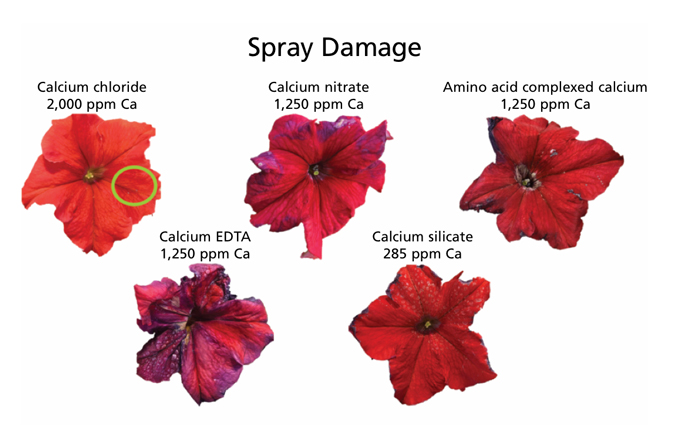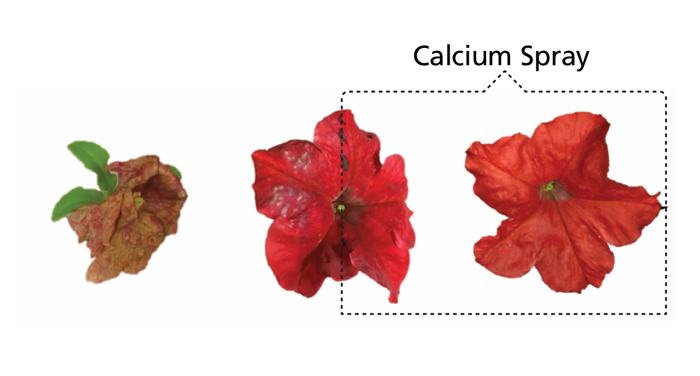12/1/2019
Making Calcium Work for You
Katherine Bennett & James E. Faust

Previously, our articles have discussed the fundamentals of calcium nutrition for plants, application methods and the observed benefits of enhancing calcium concentrations in leaves and flowers—specifically making leaves more resistant to physical damage and flowers more resistant to Botrytis infection.
Figure 1. Phytotoxicity symptoms on open petunia flowers following application of the indicated calcium source and concentration.
But before discussing the various calcium sources that we tested, it should be noted that phytotoxicity, or tissue damage, is the primary factor limiting the concentration that can applied. Phytotoxicity is a complex phenomenon that’s affected by many factors, including the plant species (and cultivar) and the environmental conditions at the time of application. Our experiments were limited to petunias treated at typical greenhouse temperatures. Growers must conduct trials on the plants that they’re growing and under their environmental conditions.
The phytotoxicity symptoms vary with the calcium source applied. Figure 1 provides examples of the damage observed to petunia flowers for each product tested. All products will cause phytotoxicity at some rate, so these are solely examples. Therefore, caution is warranted before risking your crop.
In our experimentation, phytotoxicity primarily occurred on the flowers, not the foliage. Older flowers were more susceptible than younger flowers (individual petunia flowers are open for approximately seven days). Calcium applications made to flower buds (unopened flowers) weren’t damaged by the treatments that damaged the open flowers. This suggests that applications made during bud development are inherently safer. Our data show that calcium spray applications made to flower buds are effective at reducing Botrytis infection once the flowers open.
Calcium sources
Calcium can be delivered to plants using various sources, but not all formulations provide similar results. The effectiveness of each source to increase plant resistance to Botrytis infection and the potential for phytotoxicity will vary. Following is a discussion of several calcium sources:
• Calcium chloride. The commercial formulations (DowFlake, TetraFlake) are most commonly used for snow and ice control. We compared a commercial formulation to a lab grade (highly pure) formulation and observed similar results that showed that calcium chloride caused the least phytotoxicity among the calcium sources tested.
 Figure 2. Petunia flowers were (left) untreated, (right) treated with a 1,500 ppm Ca spray, or (middle) left side untreated and right side treated. Then the flowers were inoculated with a suspension of Botrytis spores.
Figure 2. Petunia flowers were (left) untreated, (right) treated with a 1,500 ppm Ca spray, or (middle) left side untreated and right side treated. Then the flowers were inoculated with a suspension of Botrytis spores.
The highest rate of calcium tested (2,000 ppm) caused slight damage to the open petals. In regard to efficacy against Botrytis, the 1,250 and 2,000 ppm Ca treatments weren’t statistically different, thus applications in the 1,000 to 1,250 ppm Ca range provide very good resistance to Botrytis with a very low risk of phytotoxicity on petunia flowers.
• Calcium nitrate. This is a commonly used fertilizer in greenhouses. More phytotoxicity occurred on flowers treated with calcium nitrate than calcium chloride. Also, calcium nitrate was less effective for Botrytis control than calcium chloride. The 500 ppm Ca treatment with calcium nitrate was effective for Botrytis control and didn’t cause phytotoxicity. The 1,250 ppm Ca treatment improved Botrytis control, but phytotoxicity was observed. Thus, the optimal, safe rate for calcium nitrate likely resides between 500 and 1,250 ppm Ca.
• Amino acid complexed calcium (Metalosate Calcium, Metalosate Calcium Organic). We tested Metalosate Calcium, but the Organic formulation may provide a viable Botrytis management tool for organic growers. Botrytis control provided by this product increased as the calcium concentration increased from 500 to 2,000 ppm Ca; however, some phytotoxicity was observed on three to five day-old open flowers at all of the rates tested.
• Calcium chelate (Ca-EDTA). Calcium chelate caused significant phytotoxicity at all rates tested and demonstrated little effect on Botrytis. We suspect that the low efficacy on Botrytis was because the excessive phytotoxicity allowed for Botrytis to rapidly infect the flower petals. Calcium chelate should not be applied to petunia flowers.
• Calcium silicate. Calcium silicate has the added benefit of supplying silicon, which can strengthen plant tissues and has been shown to reduce fungal infections in some situations, e.g., powdery mildew on zinnias. However, calcium silicate isn’t highly soluble, so our highest treatment provided just 427 ppm Ca. This treatment only provided a moderate response to Botrytis while spray damage was still observed. Thus, the potential for calcium silicate as an effective calcium formulation isn’t promising.
• Organic liquid calcium (On-Gard). An organic liquid calcium formulation combining soy protein hydrolysate and calcium chloride is labeled for edibles and ornamentals. We didn’t use this product in our experiment, so we have no data, but this product provides a promising organic option for application on herbs and other edible crops. It’s available in the U.S. and hopefully will be available in Canada soon.
Application strategies
Article #2 (GrowerTalks, September 2019) in this series compared sprays and fertigation application as the primary methods to get the calcium into plant tissues (note: dips also are effective). We’ve found that the most popular use of calcium has been as a spray to improve flower petal resistance to Botrytis for sensitive species such as petunia and pansy. For this purpose, weekly applications starting at visible bud can be beneficial. Several calcium sources are quite inexpensive, so some growers will make preventative weekly applications or tank-mix the calcium product with other products being applied for other purposes. Wetting agents (adjuvants) can be added to improve contact of the spray.
Figure 2 demonstrates the effect of a petunia flower in which only one-half of the flower was sprayed with calcium chloride. The sprayed half was relatively free from Botrytis. The un-sprayed half has some infection, but much less than the flower that wasn’t treated with calcium. This suggests that the spray coverage doesn’t need to be perfect, as the calcium appears to move through the individual flower petal. However, we wouldn’t expect calcium to move from one petal to the next in a species that has many petals, such as roses or chrysanthemums.
While weekly applications can be a good approach, a single application made immediately prior to shipping flowering plants can also be effective. The pictures shown in Figure 2 were from a single calcium application.
Botrytis resistance to fungicides is a serious problem for the U.S. greenhouse industry. We’ve tested spores collected from commercial plants and found them to be simultaneously resistant to six chemical classes. This resistance occurs when growers use weekly preventative fungicide spray applications. Calcium application provides growers with an effective alternative to fungicides. If the number and frequency of fungicide applications are reduced, then those fungicides are likely to have much higher efficacy when you do choose to use them. Growers should consider using calcium as a baseline preventative treatment while reserving fungicides for the high-risk situations.
The results presented in this article are from research studies and observations in the field. They do not imply recommendations for commercial application nor an endorsement for any commercial product(s). Growers must exercise caution with spray applications of any kind, as damage to the crop is always a possibility. GT
Acknowledgements: The American Floral Endowment and the Floriculture Research Alliance support our research efforts exploring practical techniques to improve Botrytis management.
Katherine Bennett recently completed her M.S. degree at Clemson University and is currently a Research Scientist at Metrolina Greenhouses. James Faust is an Associate Professor at Clemson University.